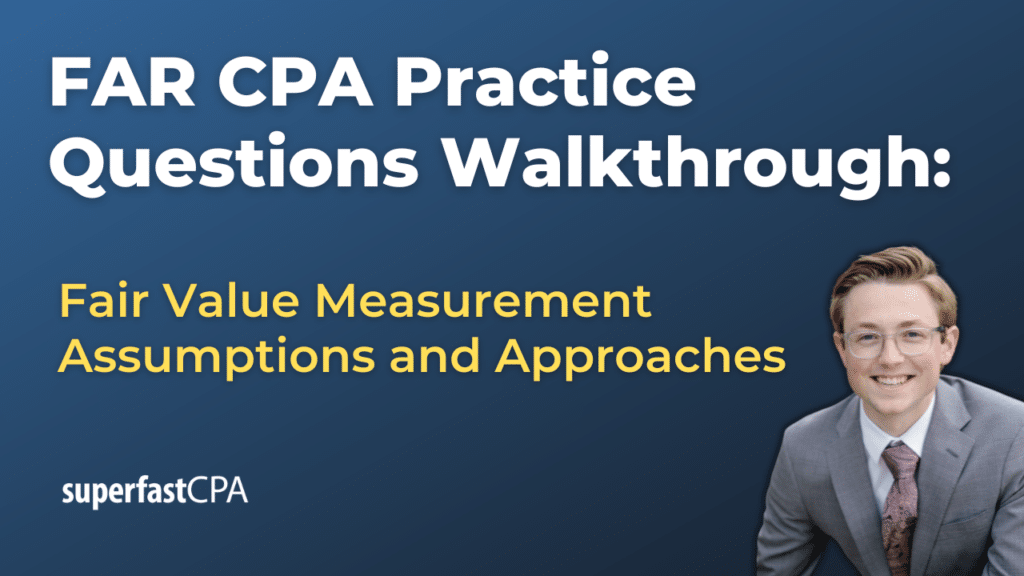In this video, we walk through 5 FAR practice questions about the different fair value measurement assumptions and approaches. These questions are from FAR content area 3 on the AICPA CPA exam blueprints: Select Transactions.
The best way to use this video is to pause each time we get to a new question in the video, and then make your own attempt at the question before watching us go through it.
Also be sure to watch one of our free webinars on the 6 “key ingredients” to an extremely effective & efficient CPA study process here…
Fair Value Measurement Assumptions and Approaches
Fair value measurement is a foundational principle in accounting that ensures assets and liabilities are valued accurately based on market conditions. We’ll cover the critical concepts of valuation approaches, highest and best use, market participants, and the most advantageous market.
What is Fair Value?
Fair value is the price that would be received to sell an asset or paid to transfer a liability in an orderly transaction between market participants at the measurement date. It reflects an exit price—the value you’d get in the market—rather than historical cost or entity-specific value.
Key Point: Fair value is market-driven and excludes transaction costs when reporting the value.
The Three Approaches to Measure Fair Value
Fair value is measured using one of three primary valuation approaches:
- Market Approach:
- This approach uses prices from actual market transactions for identical or comparable assets.
- Example: A company values a publicly traded stock using its quoted price on a stock exchange.
- Income Approach:
- Converts future cash flows into a single present value using a discount rate.
- Example: A company values a bond by discounting its future interest and principal payments.
- Cost Approach:
- Reflects the amount needed to replace the service capacity of an asset, adjusted for obsolescence.
- Example: A manufacturing machine is valued based on the cost to replace it, minus depreciation for wear and tear.
Each approach is chosen based on the nature of the asset and the available market data.
Highest and Best Use for Nonfinancial Assets
The highest and best use concept applies to nonfinancial assets and determines the use that maximizes the asset’s value. It considers three criteria:
- Physically Possible: The asset’s use must be physically feasible.
- Legally Permissible: The use must comply with laws and regulations.
- Financially Feasible: The use must generate the highest net economic benefit.
Example:
A company owns land that could be:
- Used for residential development (current value $500,000),
- Developed for commercial use (current value $800,000 but with $100,000 in costs).
The highest and best use is commercial development because it has the highest net value of $700,000 ($800,000 – $100,000).
Who Are Market Participants?
Market participants are the buyers and sellers in the market who determine fair value. They must meet these criteria:
- Independent of each other (no related-party bias).
- Knowledgeable about the asset or liability.
- Willing and able to transact.
- Acting in their economic best interest.
Example:
When valuing equipment, market participants include unrelated buyers and sellers who understand the equipment’s value and would transact at a price reflecting current market conditions.
Most Advantageous Market
When there is no principal market for an asset or liability, the company uses the most advantageous market. This is the market that provides the:
- Highest net proceeds (selling price minus transaction costs) for assets.
- Lowest net cost for liabilities.
However, while transaction costs are used to identify the most advantageous market, they are not deducted when reporting fair value.
Example:
A company is selling a specialized machine:
- Market 1: Net proceeds = $290,000, transaction costs = $12,000 → Selling Price = $302,000
- Market 2: Net proceeds = $285,000, transaction costs = $15,000 → Selling Price = $300,000
The most advantageous market is Market 1 because it provides the highest net proceeds. However, the fair value of the machine is reported as $302,000, the selling price in that market.
Unit of Account in Fair Value
The unit of account determines whether fair value is measured for:
- An individual asset or liability (instrument-by-instrument basis), or
- A group of assets or liabilities (portfolio basis).
By default, fair value is measured on an individual basis unless the accounting standard allows aggregation.
Example:
A company owns 1,000 shares of a publicly traded stock, each quoted at $50. The unit of account is each individual share unless stated otherwise:
- Fair value = 1,000 shares × $50 = $50,000.
Key Takeaways
- Fair value reflects an exit price in an orderly transaction at the measurement date.
- The three approaches to measure fair value are the Market, Income, and Cost approaches.
- Highest and best use maximizes the value of nonfinancial assets.
- Market participants are independent, knowledgeable, and economically motivated buyers and sellers.
- The most advantageous market provides the highest net proceeds, but fair value is based on the selling price.
- The unit of account determines whether assets or liabilities are measured individually or as a group.













